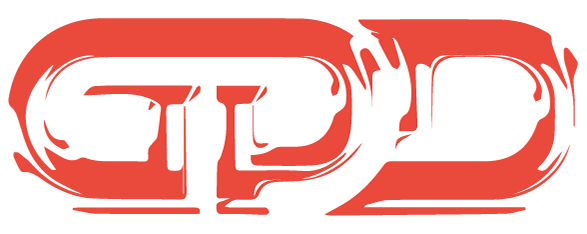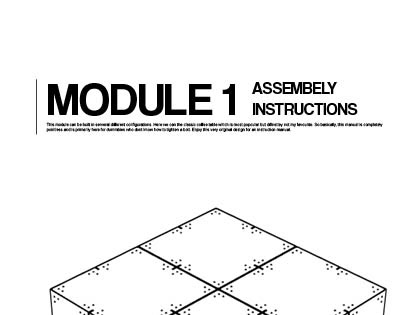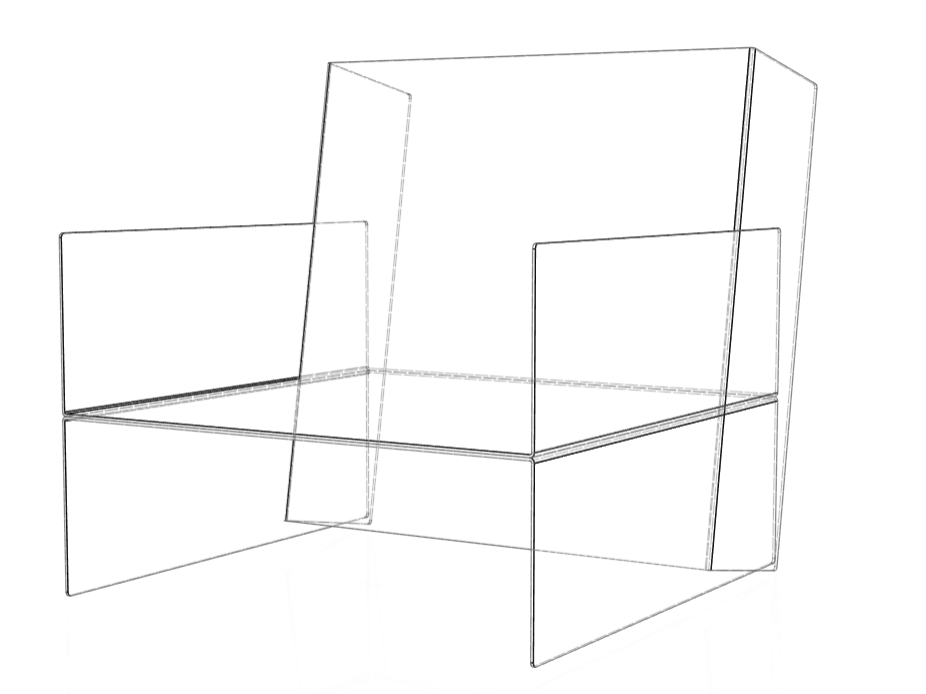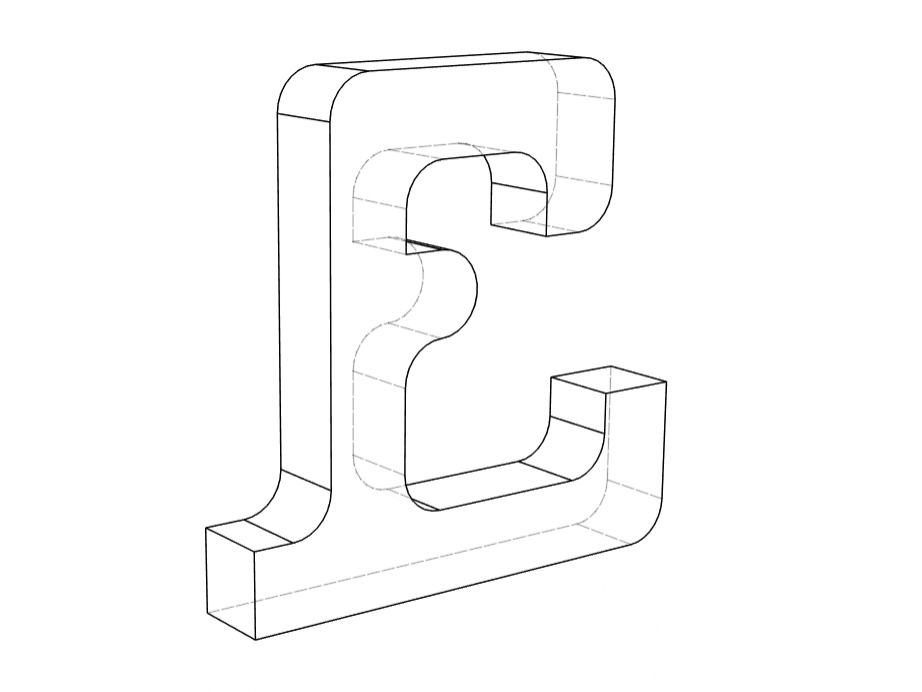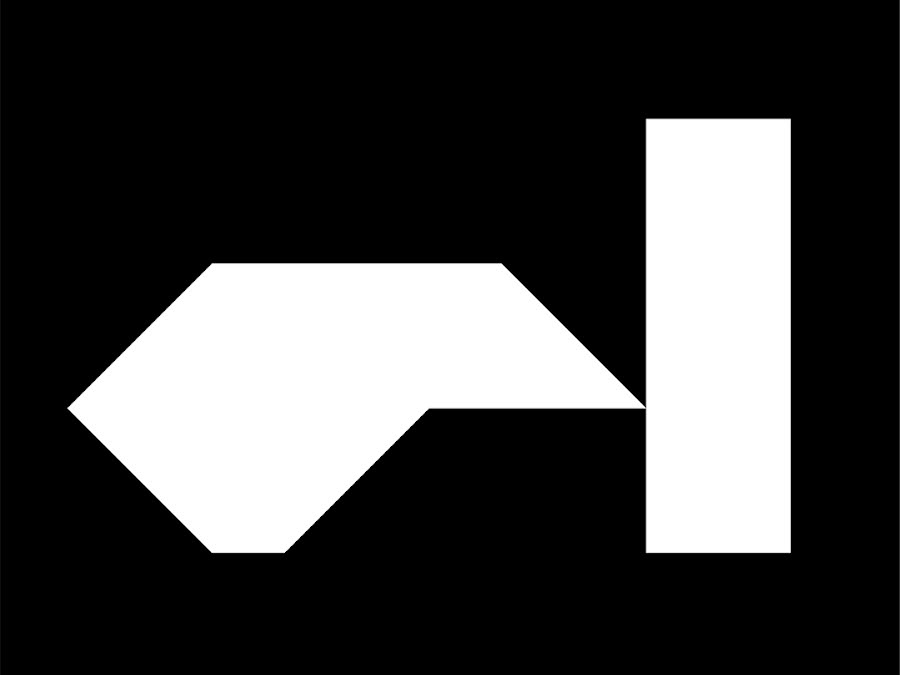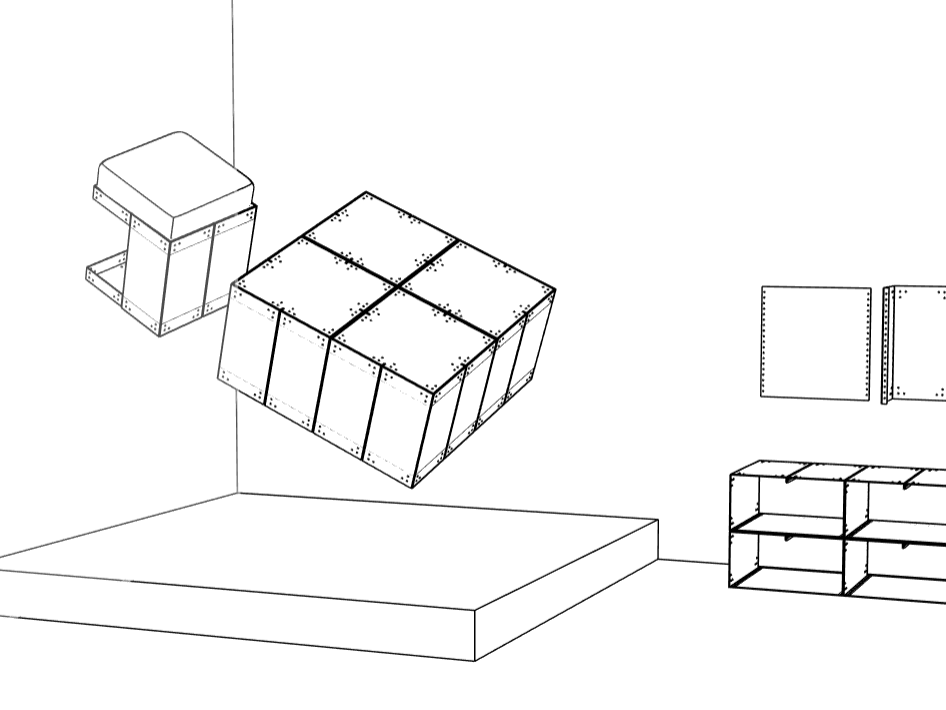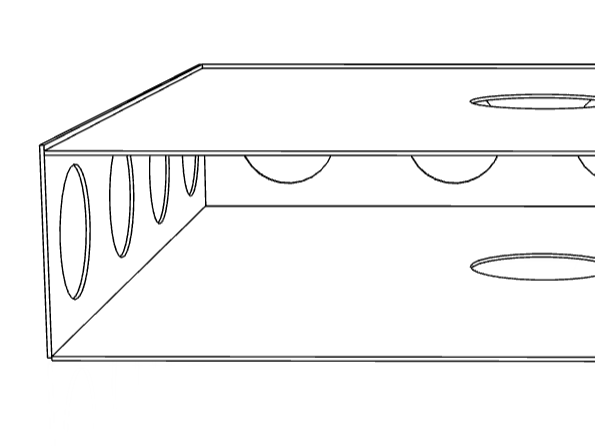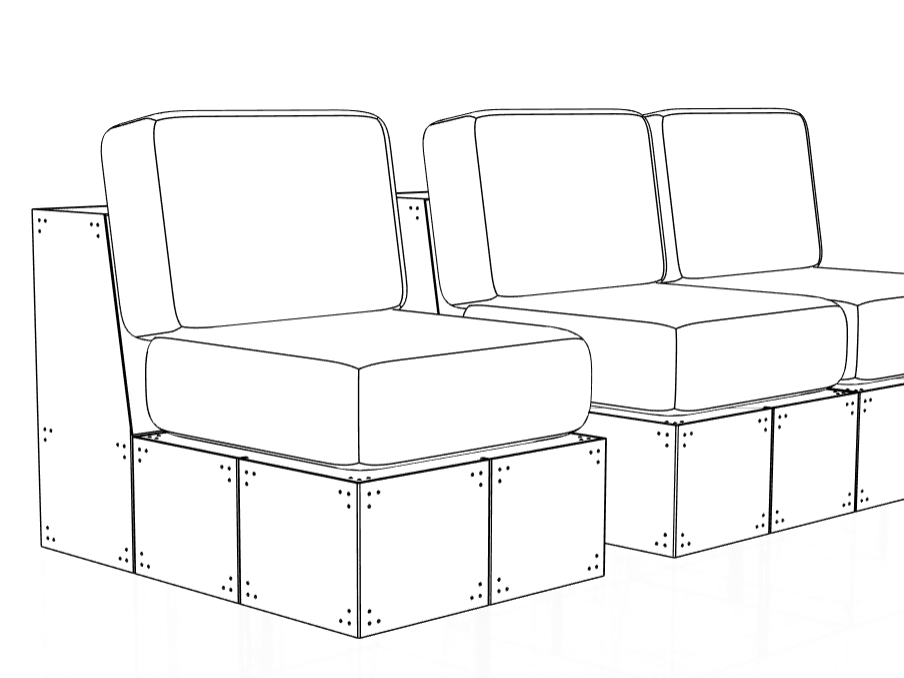This page showcases the context film created for my modular furniture system project. The narrative behind the film is rooted in the idea of connection—how objects, like the components of my modular system, can help bring people together in both public or private spaces. Through thoughtful planning, careful preparation, and a lot of creative energy, I aimed to capture the essence of how design can foster community and shared moments.
Filming this piece was an incredibly rewarding experience. It allowed me to bring all my research, development work, and conceptual thinking together into a final outcome I’m proud of. Below the film, you’ll find a detailed breakdown of the planning, storyboarding, scene development, and creative decisions that helped shape the final video.
THE BRIEF
The brief was fairly straightforward. We had to make a 1-minute context film (in landscape) that showed and demonstrated the narrative of our work. For some, it wasn't essential for their piece to be in the film. Some people had work based on heritage or work about a certain place, but I really struggled to imagine making a film with my work being the central focus. I knew my narrative and decided to start writing and exploring different ideas so I could start planning it and getting everything together.
INITIAL IDEAS
Throughout the early stages of planning my context film, I explored a variety of directions that could communicate the story of my modular furniture system. These concepts reflect different ways of expressing ideas around community, functionality, adaptability, and human connection. I listed them in order of what I think works best, from ideas that I had but I knew weren't right for the message I was trying to get across.
Idea One — Dinner Party Connection
I initially imagined a lively dinner party scene where friends gather to celebrate a special occasion. In a small, urban flat setting, guests would take modular shelves down from the walls and transform them into additional tables, ensuring everyone had a space to sit and share a meal. I envisioned a cozy, bustling atmosphere, highlighting how modular design can adapt quickly to bring people closer together in intimate domestic environments.
Idea Two — Life Around the Coffee Table
This idea evolved into the one I chose for my final film. I focused on an overhead perspective of the modular coffee table, capturing different scenes of life happening around it. The table remained centered while the background and activities changed: from quiet mornings with coffee, to makeup setups, to lively parties. This approach allowed me to document how the object adapts to various moments without needing direct performances or complex production setups.
Idea Three — Celebrating the Object [Back-Up]
Another concept I explored was creating a film solely about the final modular piece itself — almost treating the object like the main character. I envisioned shooting this on a rooftop in the golden sunlight, using sweeping drone footage and slow, cinematic movements. Without actors, the film would rely on strong visuals and a powerful audio track to convey ideas of freedom, flexibility, and architectural beauty.
Idea Four — Public Space Activation
I considered a narrative where the modular furniture system was used in a public setting, such as a community park or urban plaza. Individuals would arrive one by one, each bringing a single modular component. As they assemble their pieces together, a shared space would organically form: seating, surfaces, and structures growing naturally as more people joined in. The focus would be on building community through collaboration.
Idea Five — Object as Performance
Another idea was to create a choreographed performance piece where people interact with the modular system almost like dancers. Each movement — lifting, placing, connecting — would be deliberate and rhythmic, turning the act of building into an expressive performance. Filmed in a large minimalist studio with dramatic lighting, this concept would emphasize the modular design’s balance between form and function.
As you can see, I listed these ideas which I thought could potentially work, and I liked how the narrative came across, and another idea which I have decided against. I originally thought Idea Five could be like Isla Paine's, as I really liked the direction she followed; however, it didn't fit or suit my narrative or the style of my work. I really liked ideas One and Two and wondered if I could take parts of both ideas to blend into one. I stopped thinking of my own ideas and started looking at films and adverts to get inspiration.
Research
I thought the most appropriate thing to get more ideas flowing was to look at Furniture adverts, and different short films, so i could get an idea of different filming styles and storylines.
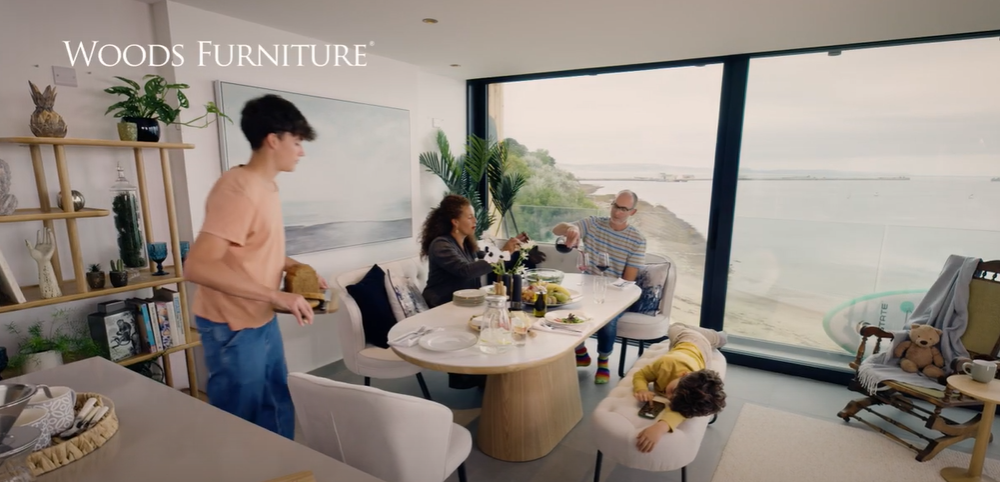
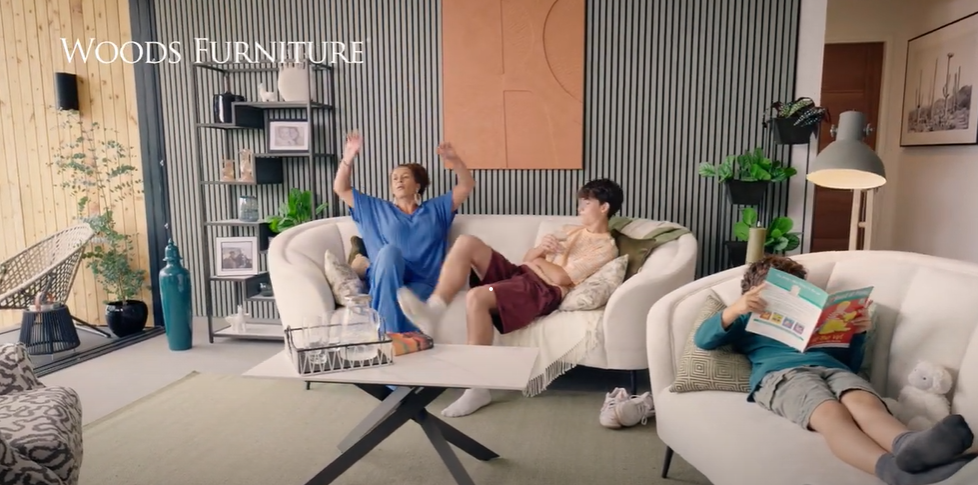

I looked at a Woods Furniture advert that explores a similar narrative to what I want to create — bringing family and friends together to enjoy time in the space you call home. While the concept aligned with my ideas, I wasn’t a fan of the execution. The video showcases people enjoying various pieces of cozy, homely furniture, but that’s not the direction I want to take. I didn’t want to use multiple panning shots, especially since my film only features one table. I also found the overall aesthetic too soft and bright. My piece leans into a more brutalist style, which doesn’t align with the “happy family” atmosphere portrayed in this advert.
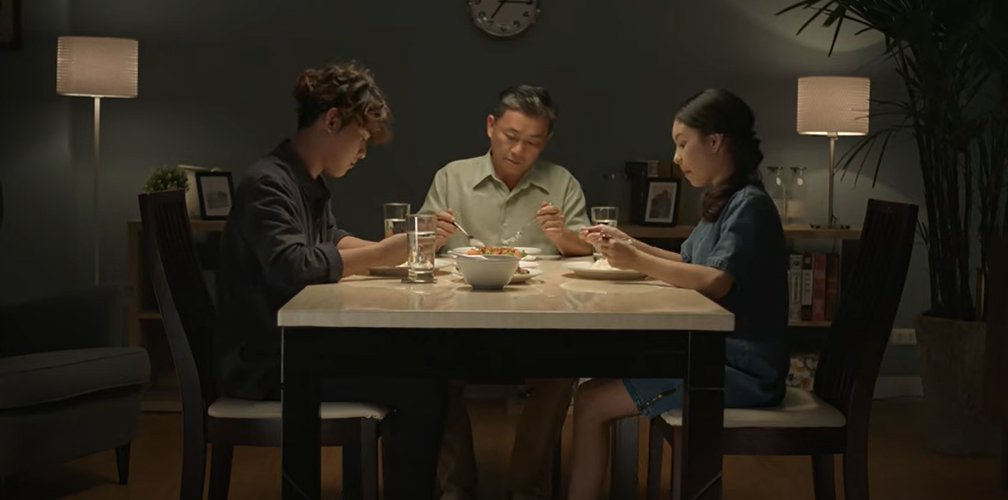
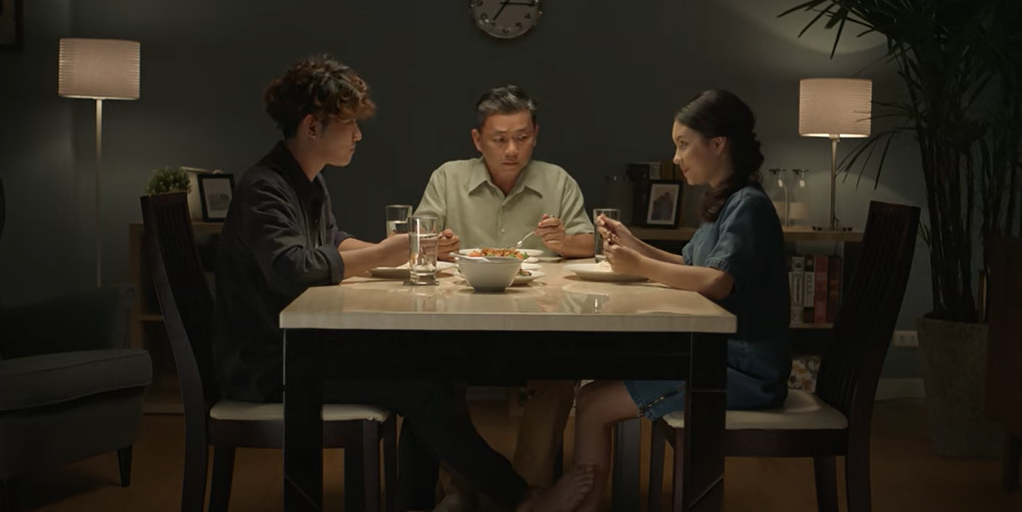
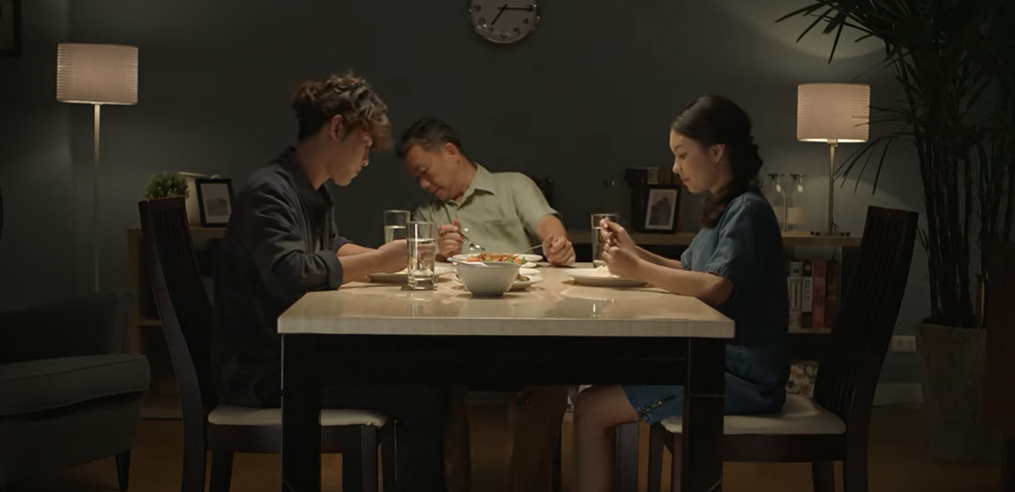

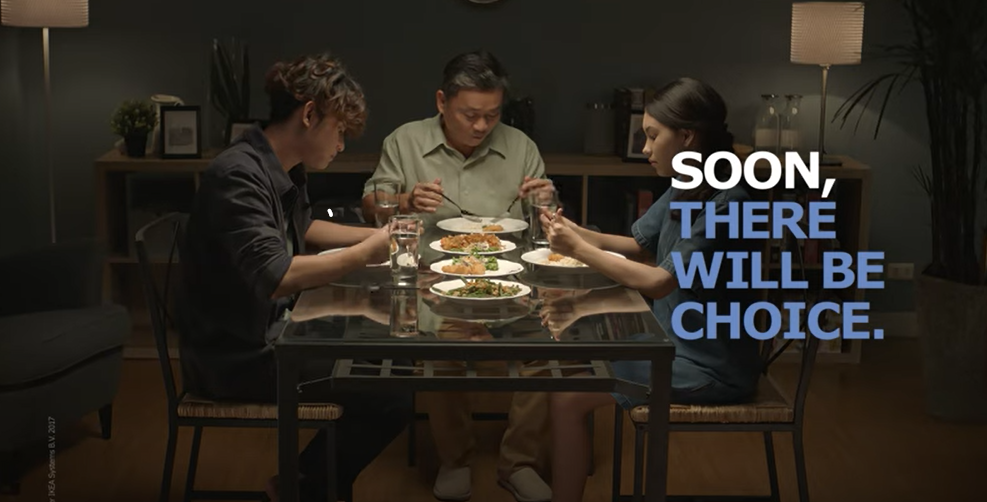
I loved the playfulness of this advert. Once again, it draws inspiration from the furniture giant IKEA. The advert builds on the narrative: “You can’t choose her boyfriend, but you can choose your dining table.”
The short film is shot from a single, fixed angle — similar to how I envisioned shooting Idea Two — and it's essentially a dinner scene, much like Idea One.
It opens with a father, his daughter, and her boyfriend having dinner together. Partway through the meal, the boyfriend subtly slides his foot up the daughter’s leg. The father, sensing something is off, glances suspiciously under the table. But by the time he looks, the boyfriend has already pulled his foot back, covering his tracks.
The scene then cuts to a series of IKEA’s different dining table designs, eventually landing on a glass-top table. When the scene returns to the dinner setting — now with the glass table — it’s clear that the boyfriend can no longer get away with anything sneaky under the surface.
The advert closes with a clever tagline: “Soon, there will be a choice” — nodding not only to IKEA’s wide range of furniture, but also humorously suggesting there may be a better choice of boyfriend.
This advert is playful, cinematic, and sarcastic — all qualities I’d love to bring into my own film.
Now that I had some storyline ideas, I wanted to explore films that use overhead shots. I came across a video by the fashion brand Derschutze, which uses this style to showcase their new seasonal drop. The overhead angle gives the video a really cinematic feel and offers a unique perspective that we don’t usually see. While the video doesn’t follow a specific storyline, it quickly cuts between shots of the model in different outfits, surrounded by a range of accessories.
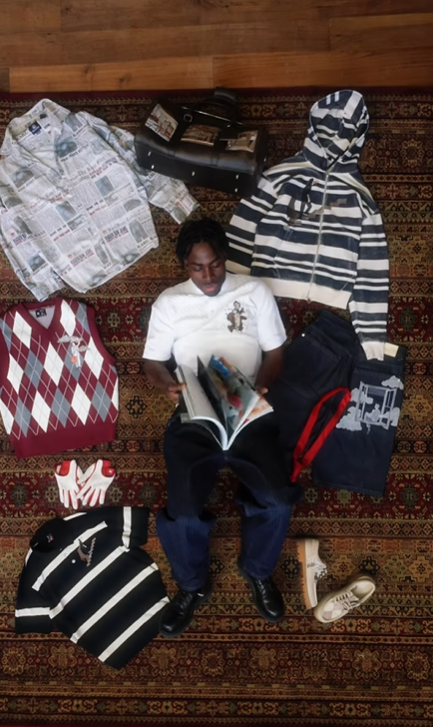
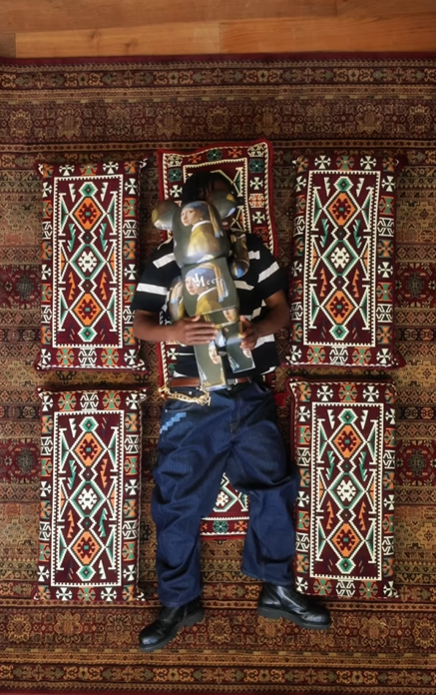

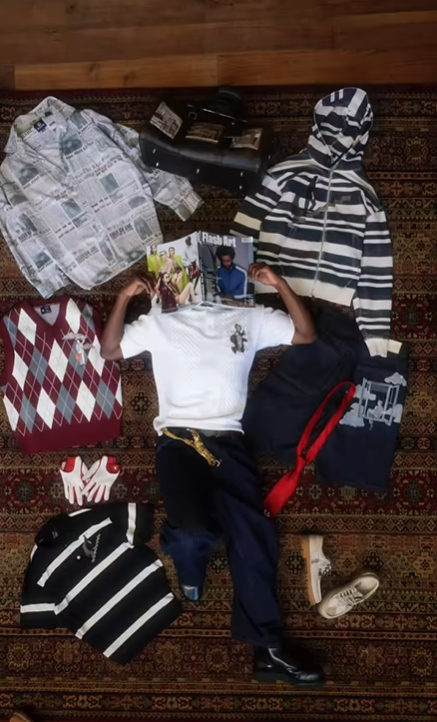
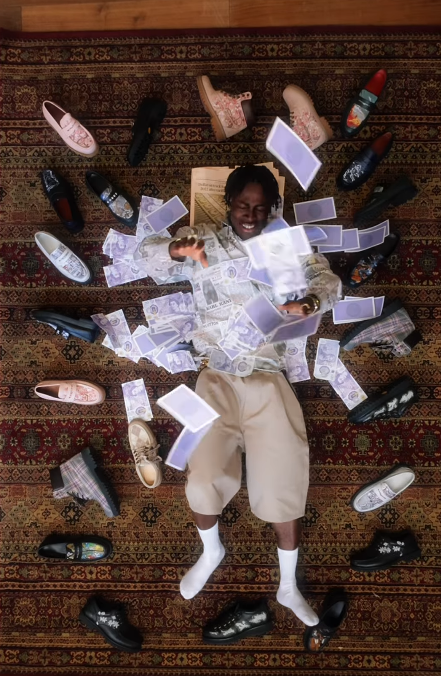
Tagline
For this film and the piece in general, I know I wanted a tagline to summarise the context. I have had many ideas, but I've listed a few of the options below:
Connections are Made.
Something's just click.
Designed for Connection
Where pieces and people align.
Built to come together.
CURATING IDEAS
As I still had lots of ideas floating around, I was really struggling with creating a set direction. The only things that were for definite were that I wanted to push my narrative of connecting people through design, I didn't want to star in the film myself, and I wanted clips of people building my pieces.
I had 2 shots in mind that I wanted to flip between. The overhead shot of the piece [built or being built] and a wide-angle shot of a TV stand, on which the piece will sit in front of.
Location
Since I couldn’t settle on a specific idea, I decided the best next step was to explore potential filming locations. I hoped that visiting different spaces would help steer my decision and allow the environment to inspire the concept.
1.Beehive Mill
The first location I looked into was Beehive Mill in Ancoats. I knew many of the rooms had recently been renovated and were largely empty. I had a connection to the building, having previously worked with a business based there. I’ve always appreciated the rich Mancunian character of the space, so I reached out to the building manager, Carl, to ask about filming opportunities. He showed me a large, completely empty room with beautiful old hardwood floors and exposed brick walls—an aesthetic that I felt would really make my metal furniture pieces stand out.
However, I had some concerns. I was still leaning toward a more domestic-style setting, and filling such a large space with appropriate furniture would be challenging. On top of that, Carl reminded me that the flooring is part of the building’s Grade II listed status, and any sharp-edged pieces would need to be handled with extra care, which added a layer of complication.
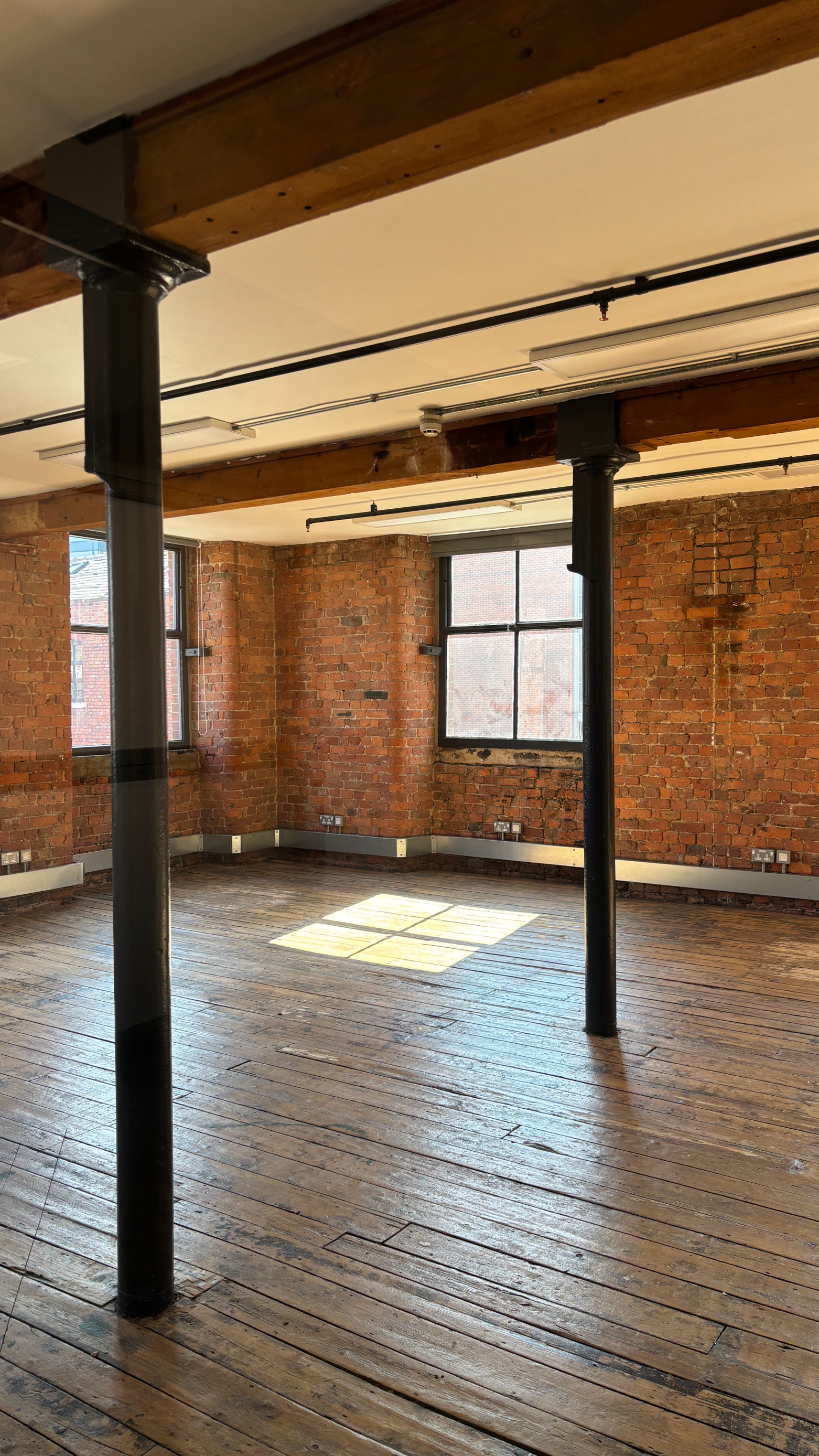

2.Lil's Flat
Lil is a widely known ceramics artist based in Manchester whom we all know too well. Whilst speaking to Lil about my project and the struggles with developing an idea in the right space, she kindly offered her flat as a space to film. This would have been perfect, but with our schedules colliding, we couldn't work out an appropriate time frame, as she was also super busy.
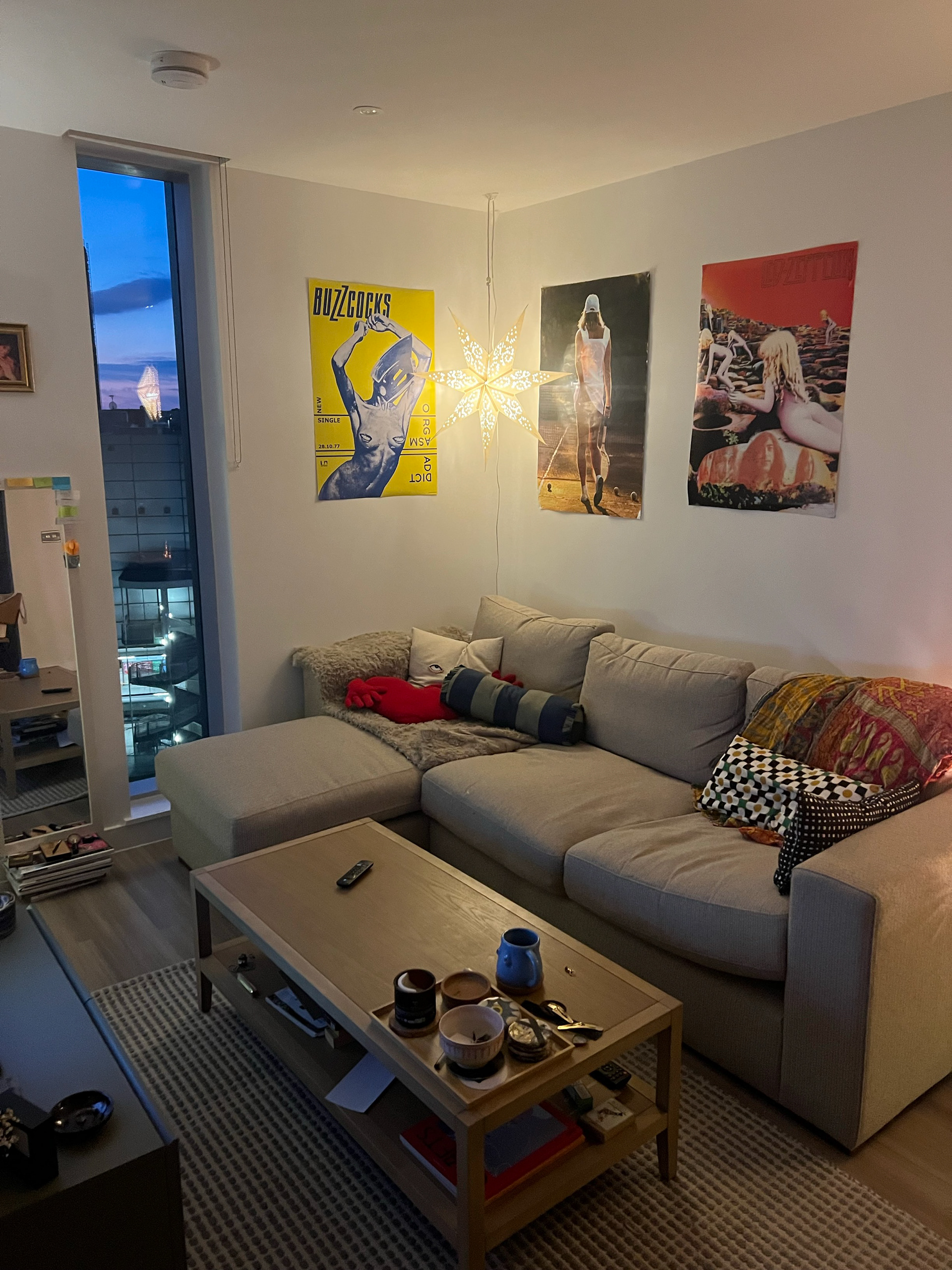
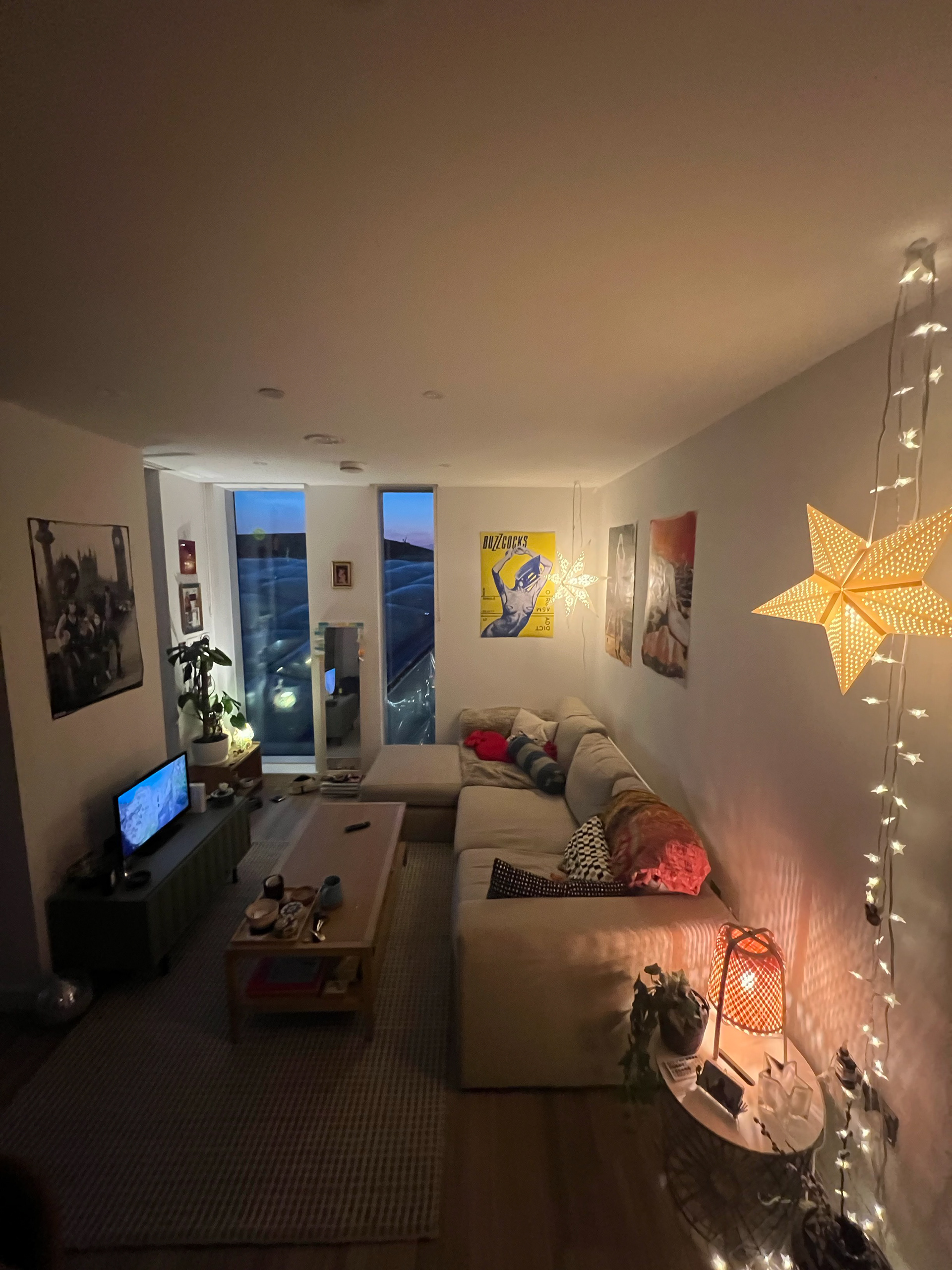
3.Wellington House
Another industrial space that was recommended to me was Wellington House. Similar to Beehive Mill, it’s an old factory building with large, open, and mostly empty rooms. However, the aesthetic was quite different—rather than red brick walls and wooden floors, Wellington House had white walls paired with cracked concrete flooring, giving the space a much more raw, almost haunted atmosphere. I felt this setting would complement the brutalist design of my pieces really well. While it wasn’t my first choice, I definitely considered it as part of Idea 3—a strong backup plan in case my primary locations didn’t work out.
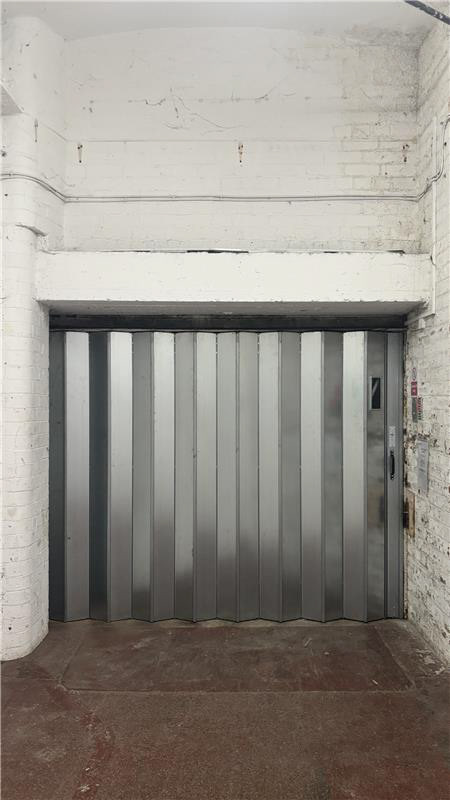

4.My Flat
I hadn’t originally considered filming in my own home, but after struggling to coordinate schedules with Lil, I realised—what better place than my own space? My flat was spacious enough to accommodate most of the concepts I had in mind, and it featured exactly the aesthetic I was after: brutalist concrete walls, exposed steel tubing, and an industrial edge that perfectly matched the style of my work. On top of that, it already housed some of the other furniture pieces I had built, making it an ideal and authentic setting for the shoot.
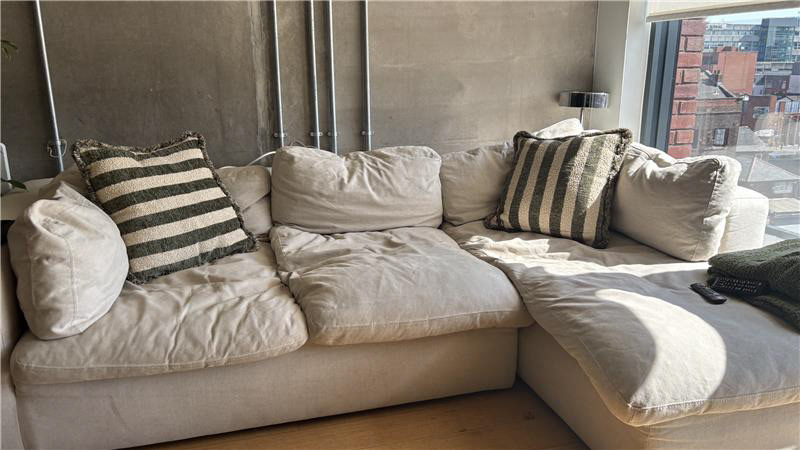
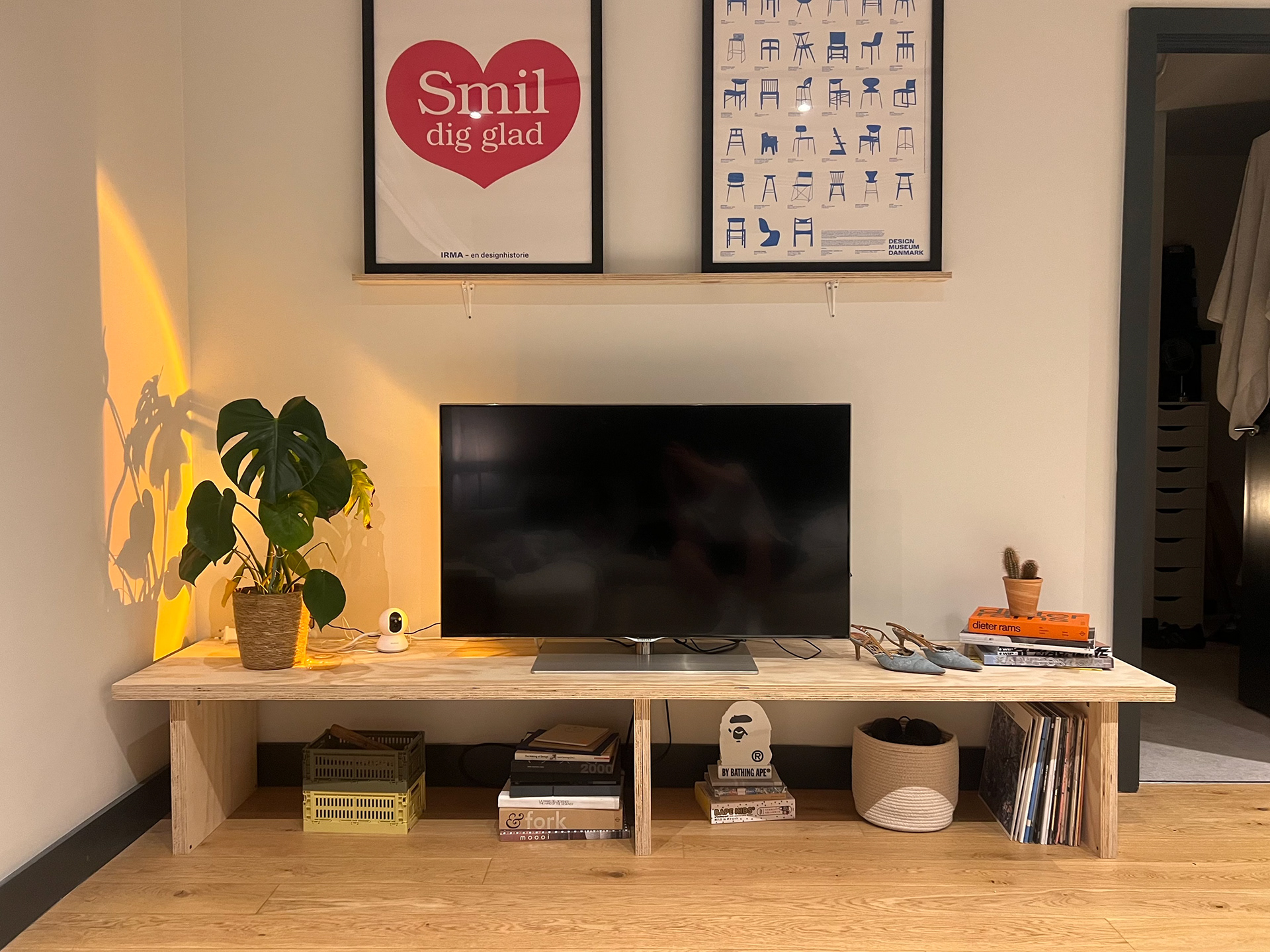
This also meant I could get the manufacturers to deliver my work here, meaning I didn't have to lug the pieces across Manchester and potentially risk damaging any of the components.
Casting

I put out a casting call for my story to try to get models to star in my film. I didn't explicitly say what it was about, but I suggested I was looking for a couple. I needed to see if there was anyone interested in doing this before sending them all of the information across. I was glad to see some friends reach out and say they would love to and were available during the late afternoon of the 7th.
This was so relieving, as I was already stressed about getting my pieces in time. I put this story up the same day that I was notified that my pieces were going to be delivered on Tuesday, the 6th. This gave me enough time to film edit and wrap everything up come friday.
Joe & Emelia
Joe was the first person to reach out to me. I have been friends with Joe for a few years now, and he is someone I used to live with. He doesn't usually get involved with stuff like this, but was keen to help out. After some discussion explaining to him some ideas, he and Emeila were both free the evening of the 7th. This was perfect, and I was so happy the first people to contact me were free and up for it.
This later all changed when production of my pieces was delayed, and they both had full schedules on the other days I could film.
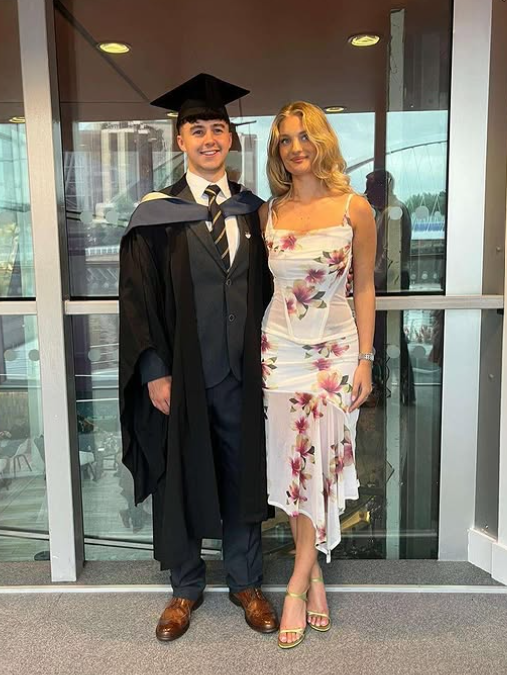
Ellie & Alex
After a delay in production and limited response from others I had initially contacted, I decided to reach out to two friends I’ve known since the start of college—Ellie and Alex. Though not a couple in real life, their long-standing friendship and natural chemistry made them the perfect fit for the roles of Mr. and Mrs. Price.
Both Ellie and Alex come from creative degree backgrounds and had experience participating in similar projects. I knew they would understand the tone, rhythm, and humour I was aiming for, and they brought a thoughtful, professional energy to the shoot that elevated the final result.
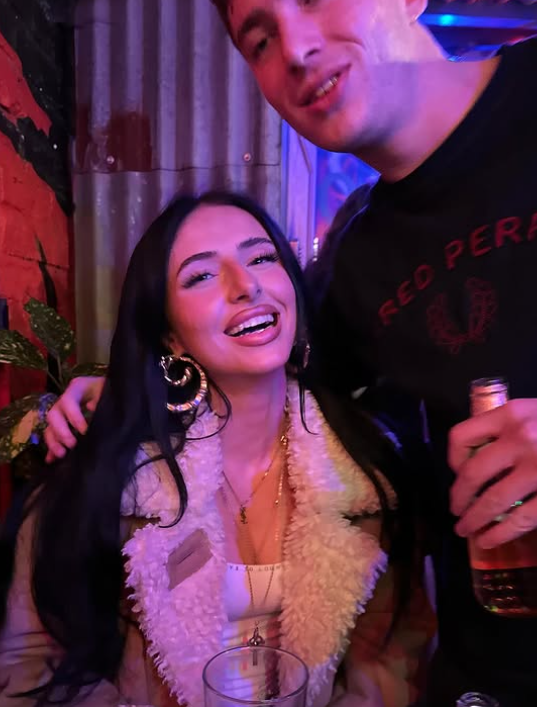
My original aim was to cast a real couple to avoid any awkwardness or tension that can sometimes arise between two strangers—especially when filming intimate or playful scenes. It’s not always easy to feel relaxed in front of new people, and that discomfort can be magnified when there’s a camera pointed at you.
This is why I ultimately decided to cast Ellie and Alex, two close friends I’ve known for years. Their existing friendship and comfort with each other—and with me—meant we could create a relaxed, collaborative environment on set. That ease and connection come through on screen, which was essential to making the characters feel believable and the narrative feel genuine.
Equipment and Props
Camera
I already owned and had access to a camera, so there was no need to rent one. I used a Canon EOS 250D paired with a wide-angle lens, which helped capture more of the environment—especially useful when shooting in tight spaces like my flat.
Tripods
I didn’t have my own tripod, so I looked into renting or borrowing. Luckily, Astrid had everything I needed and more, including two adjustable tripods (extending up to 2 metres) and a boom arm for the overhead shots. I opted to stick with warm natural lighting rather than artificial studio lights. This choice was intentional—I wanted the film to have a raw, lifelike quality that matches the tone and context of the project.
Filming Props
Since I wanted this to feel like an actual short film rather than just a video explaining the context, I felt it was important to include props that grounded the narrative. I designed and made an instruction manual for my furniture piece to make it feel like a real, market-ready product. I also sourced a cardboard box large enough to fit all the components as if it were being unboxed in a domestic setting. Additional props—like books, plants, and decor—were simply items we had lying around the house, used to make the set feel more lived-in and natural.
Concept Refinement
This short promotional film explores the emotional and functional dimensions of design through a playful, domestic narrative. Centred around a modular coffee table, the story follows a couple, Mr and Mrs Price, as they excitedly receive, unpack, and assemble their new piece of furniture. Framed in stylised humour, warmth, and a strong visual identity, the film celebrates both the physical connections in the product’s assembly and the emotional connections it fosters within the home. With a balance of minimalism, stylised symmetry, and subtle storytelling, the piece is as much a love letter to design as it is to partnership.
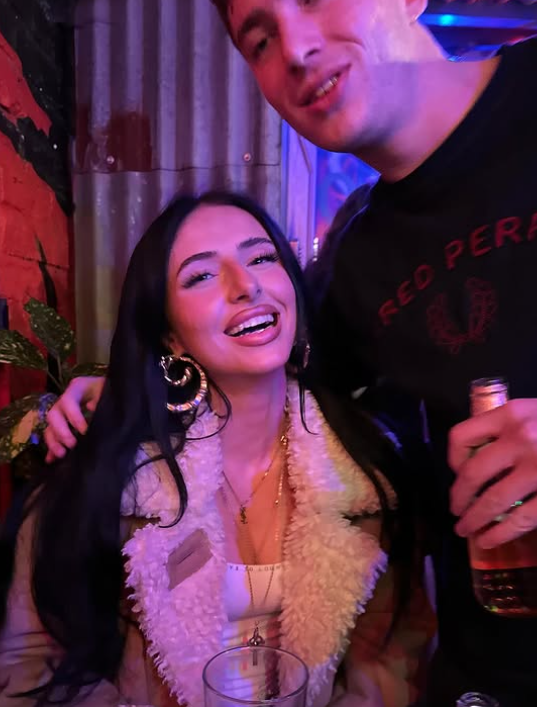
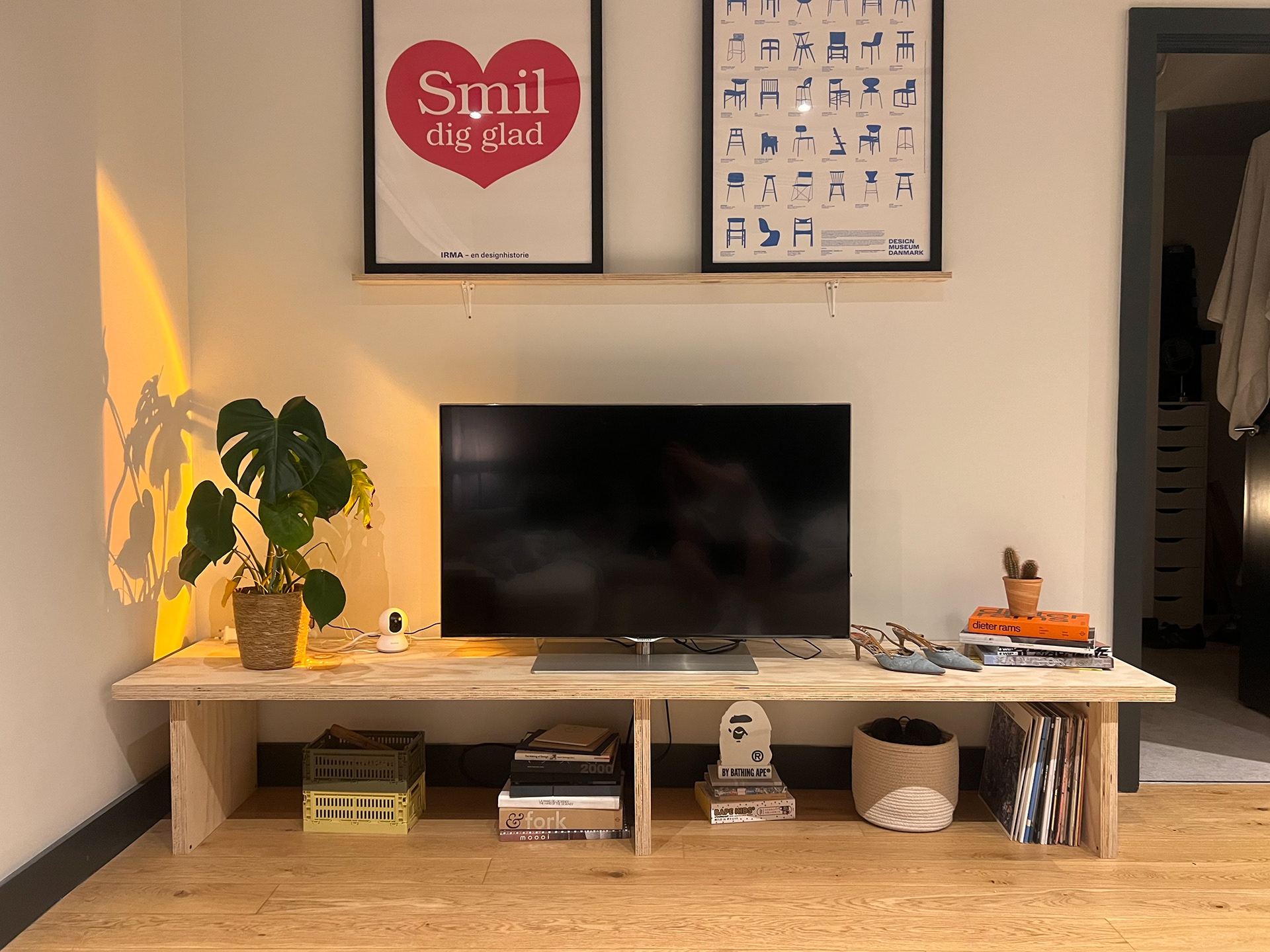
Summary
The film begins with a knock at the door. Mr. and Mrs. Price open it in unison, brimming with enthusiasm as they receive a flat-pack package from a delivery man. With exaggerated energy, they grab the box and slam the door shut. Inside their living room, the couple places the package center-frame and shares a silent but triumphant high-five.
From there, the story unfolds in clean overhead and wide shots: unboxing the parts, laying them out with aesthetic precision, and working together to build the table. As they finish, the mood shifts. Mr. Price rests against the finished product while Mrs. Price eagerly decorates it with plants, books, and candles. A comedic beat follows — Mr. Price casually puts his feet on the table, only for Mrs. Price to smack them off with a magazine. The room grows dimmer and warmer, settling into a soft, cozy atmosphere.
The film closes with a still shot of the table — a symbol of shared effort, connection, and design. A voiceover delivers the final line: “Connections come in many forms… but special ones come from Bracket.”
I had committed to this being my final idea and was fully prepared to shoot on Thursday evening. Then came another setback—my pieces were delayed yet again. After repeatedly chasing the supplier, I was finally told they would definitely arrive on Friday morning. These delays had already caused a knock-on effect: I lost my original two models, who were only available on Wednesday night. Now, I was left hoping that my backup models would still be available on Friday. As expected, only Alex was still free—Ellie had already made other plans. Given the intimate nature of the film concept, finding a new subject at the last minute proved difficult and forced me to rethink my casting options once again.
Story Board
I knew the most effective way to communicate my vision to the cast was through visuals. I took quick reference photos at the filming location to show how I wanted each scene to be framed. I then drew over these images to illustrate where I wanted the actors positioned, what actions they should take, and any key lines or expressions. While I started with some more detailed drawings, I eventually simplified the process by sketching quick figures to save time.

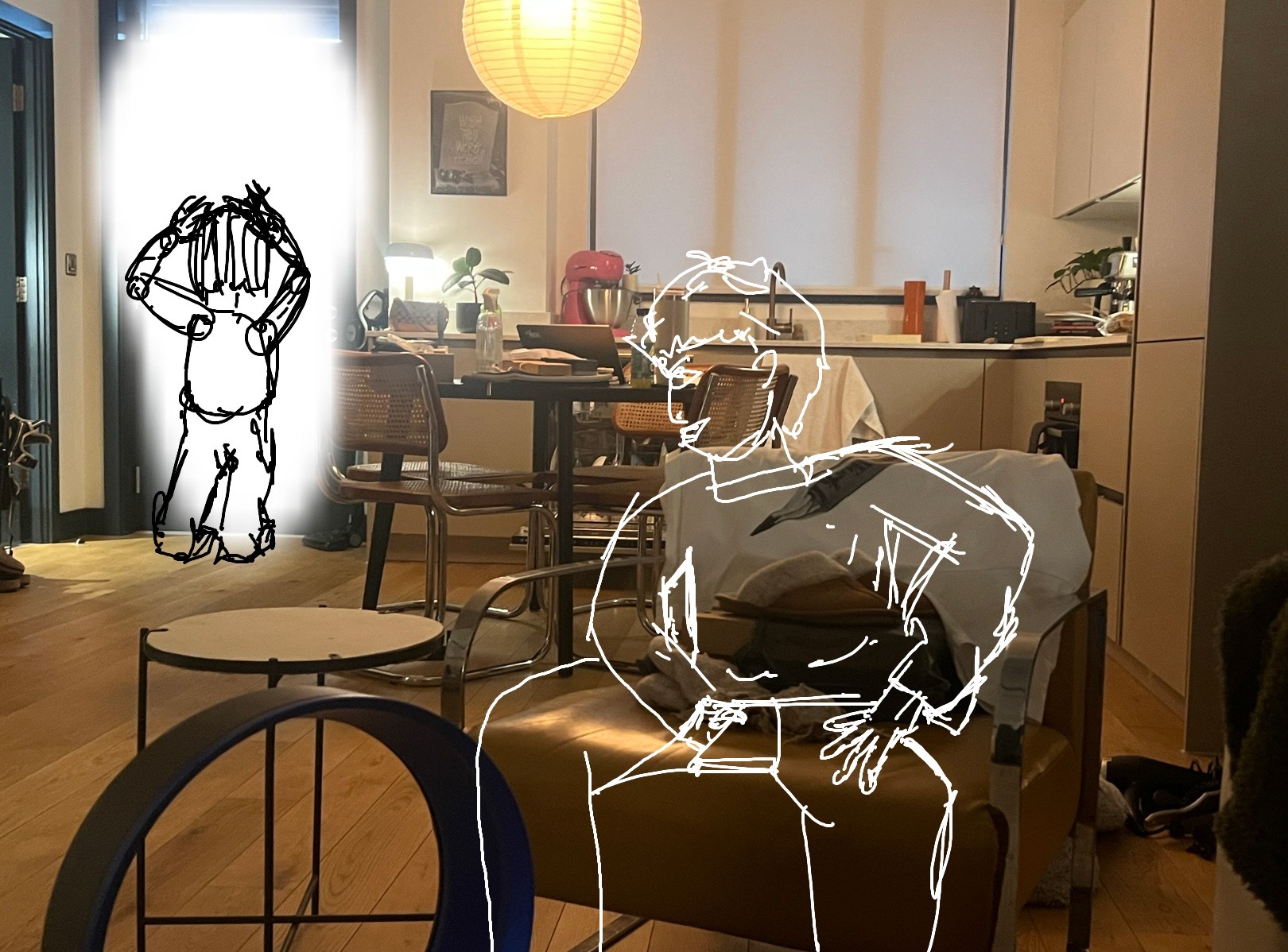

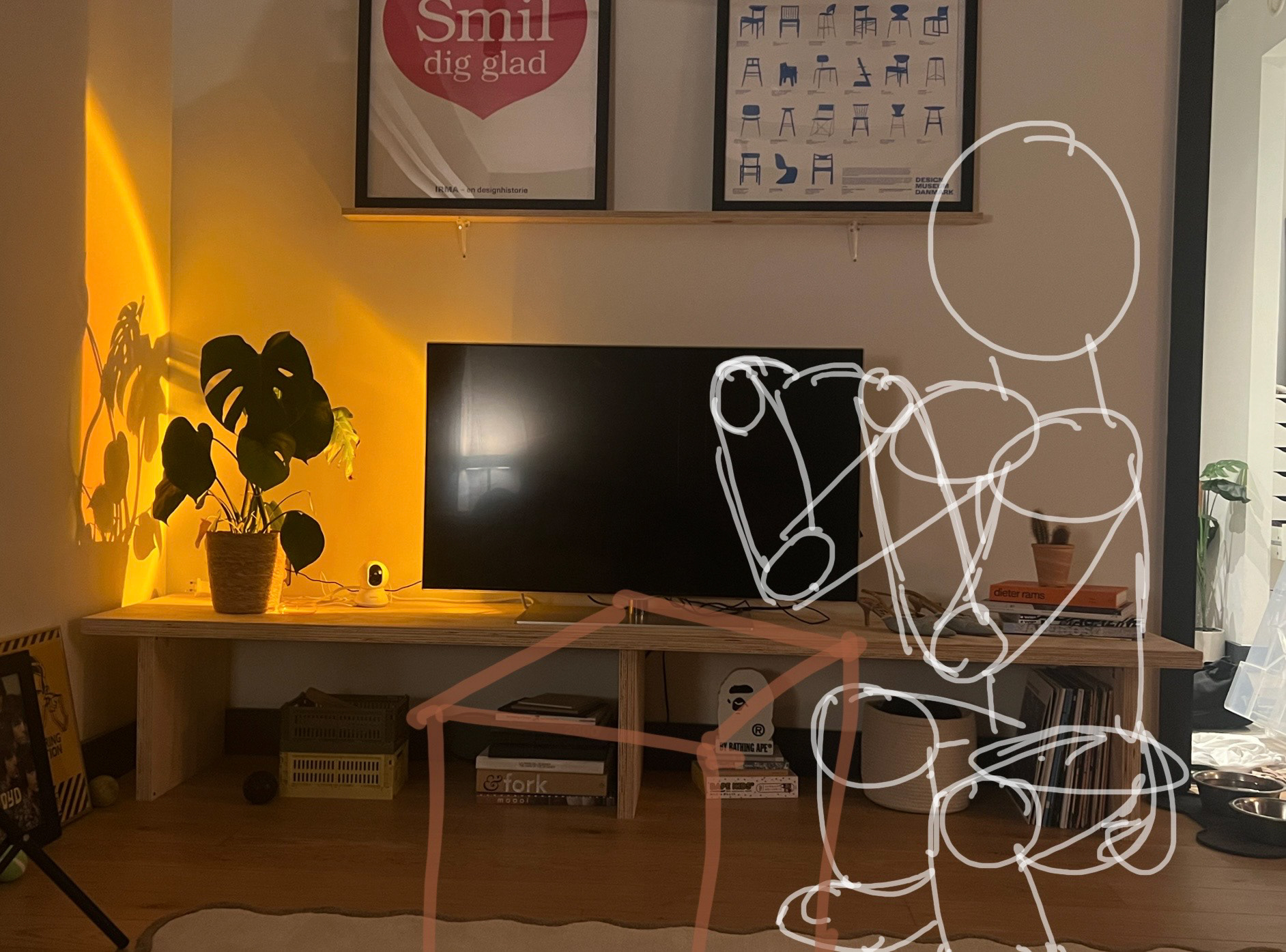
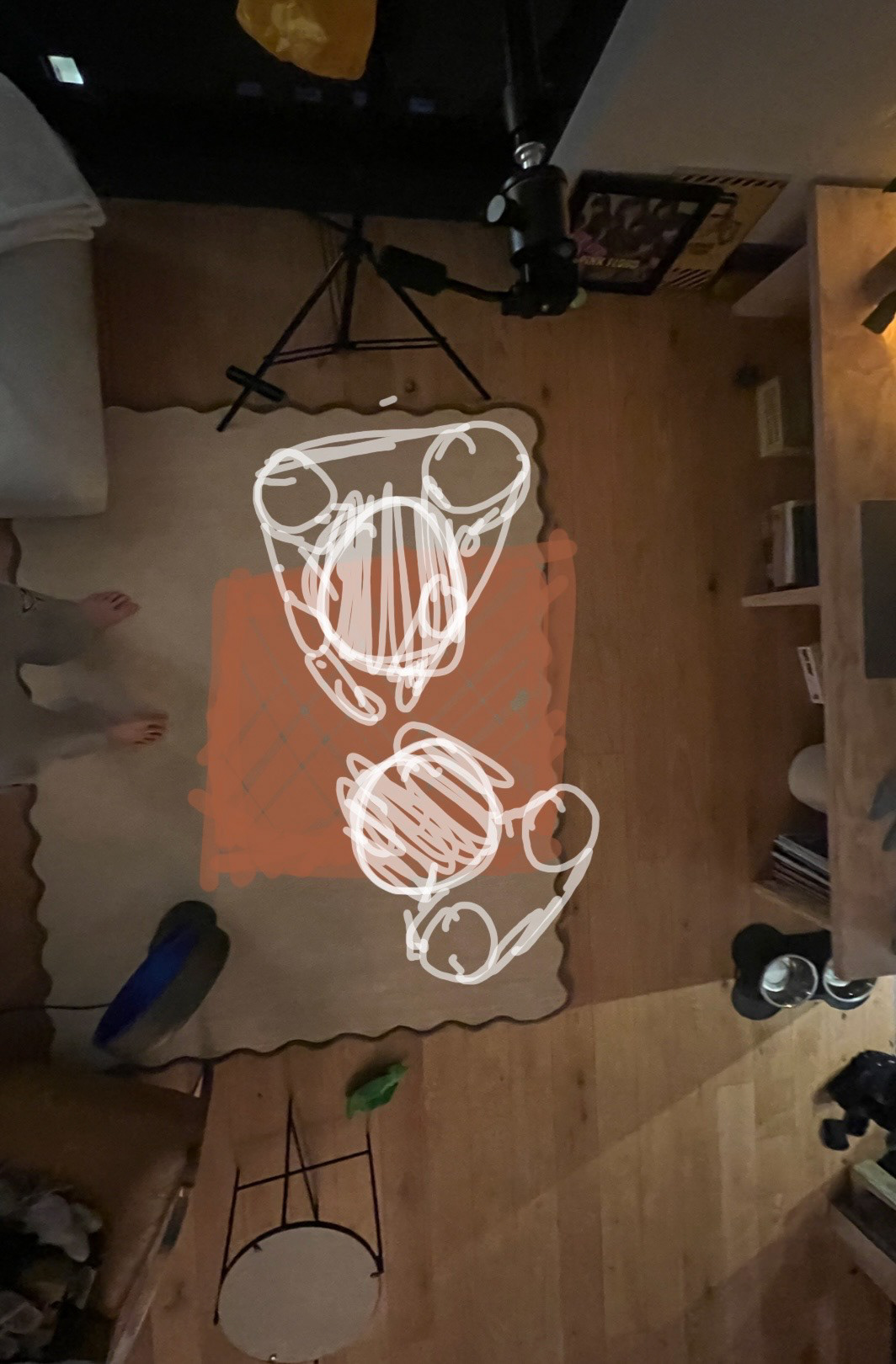
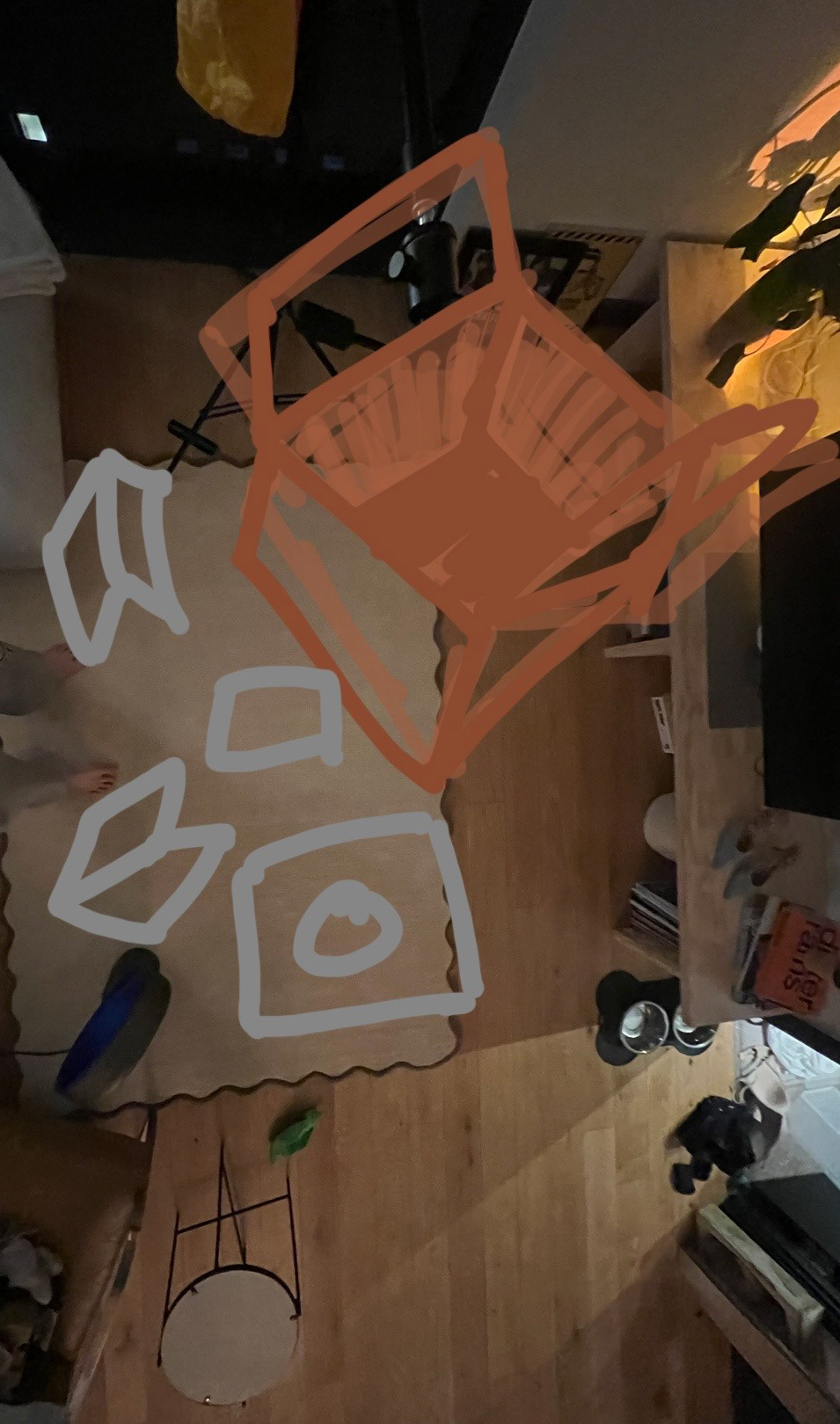
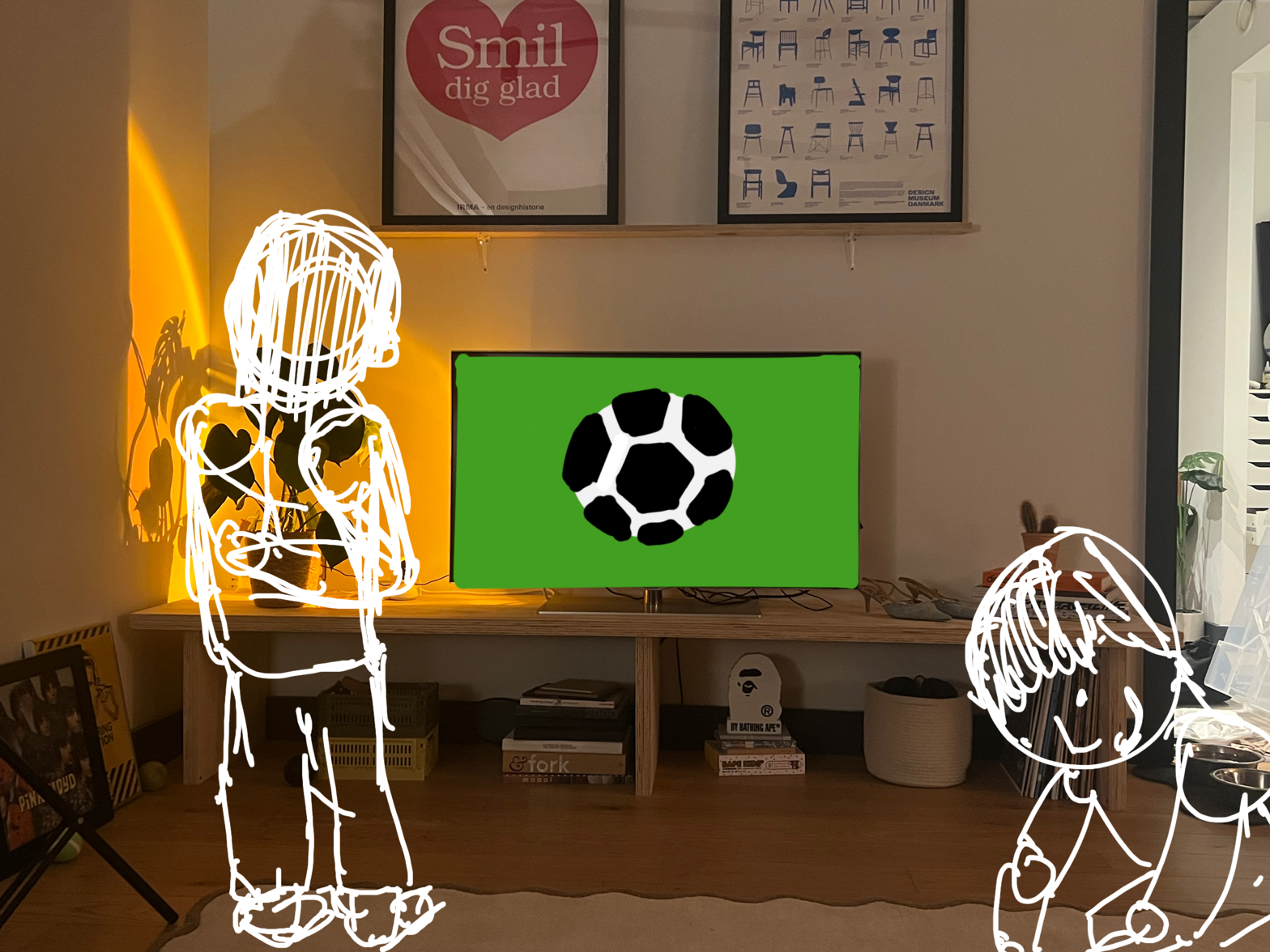
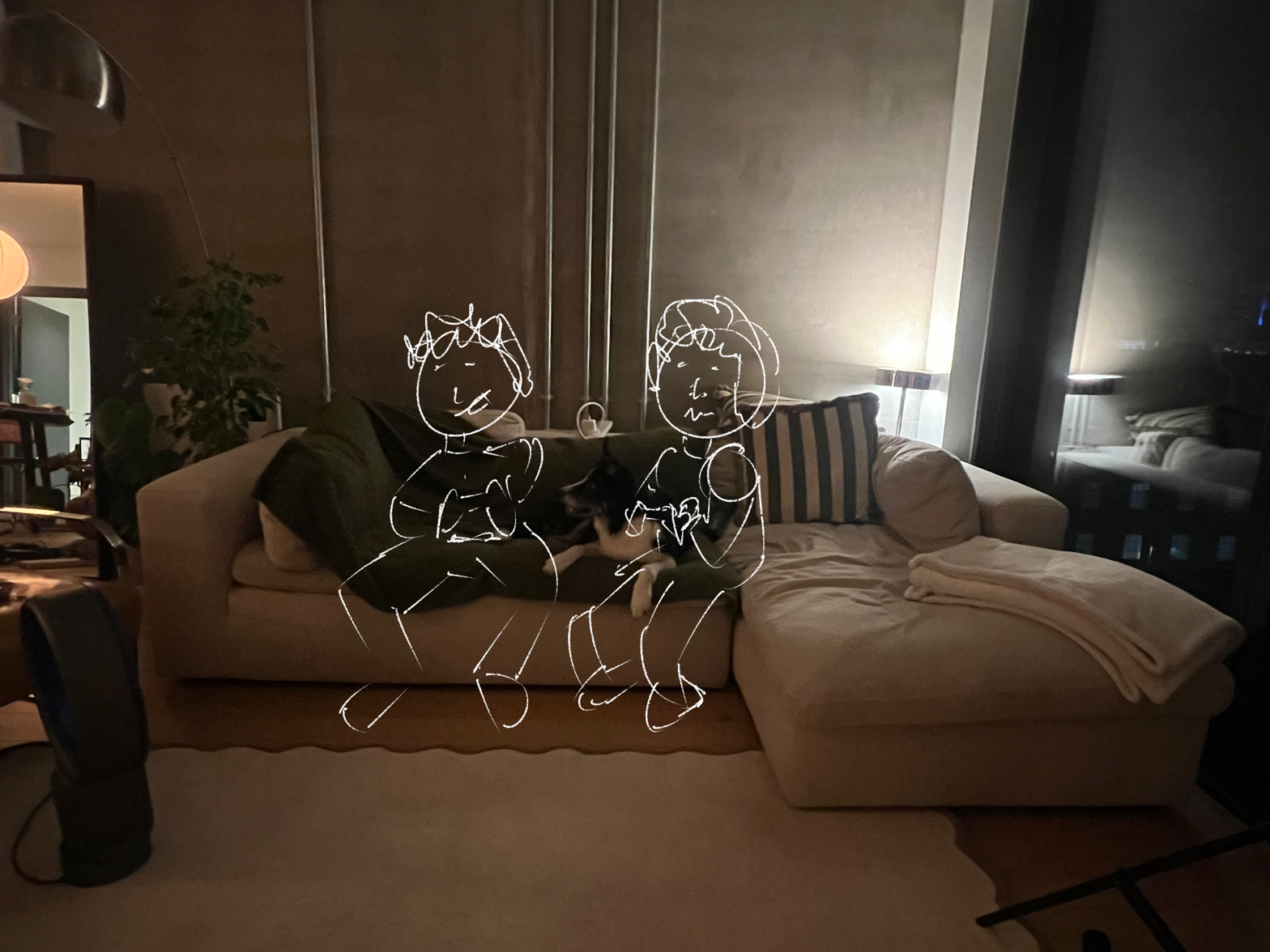
Final Shoot Plan
Similar to my previous concept, I wanted to keep the shots and overall story nearly the same. As a last-ditch effort, I managed to get another friend to step in and help. The only issue was that both of my available models were male, and I didn’t think continuing with the intimate, romantic setting would be appropriate or comfortable for them. Instead, I adapted the narrative slightly—shifting the focus to the connection of friendship.
I still planned to shoot in my flat, but I revised the storyline to better suit the cast. I wanted to film all the same scenes, but with a new tone. Rather than ending with a couple snuggled on the sofa, the film would now close on a more wholesome, light-hearted note—with the two friends sitting on the sofa in front of the coffee table, playing video games, drinking, and joking around.
New Cast
Alfie Hudson Chang
22 /yo
Alex Robinson
22 /yo
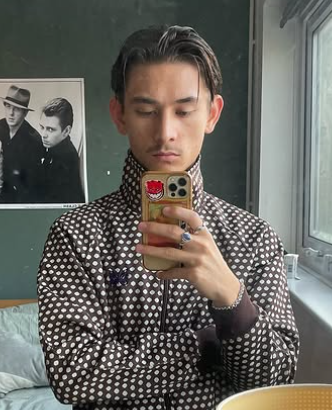

New Story & Revised Script
This short film is a one-minute promotional piece for my modular coffee table. I originally developed the idea around a romantic, date-night narrative — but after a last-minute cast change, I decided to adapt the story to better suit the two models I had available: two close mates, both male. Rather than forcing a dynamic that didn’t feel natural or comfortable, I reshaped the concept around a more casual and honest connection — friendship.
The film is set in my flat, and it follows the arrival, unboxing, and build of the modular piece. The tone is light, a bit playful, and grounded in everyday realism. It opens with the knock at the door, an exciting delivery, and builds through a slightly chaotic but satisfying furniture assembly process. The energy between the characters is relaxed and fun — one is fully invested in building, the other more distracted by the football on TV. The dynamic captures the idea that connection doesn’t always have to be emotional or intimate — sometimes it’s just two mates hanging out, taking the piss, and sharing a win (both in FIFA and in furniture building).
The final scene shows them sat on the sofa, drinks in hand, controllers out, laughing and playing games — and the coffee table now sits between them, fully built, in use, and the centerpiece of their evening. The closing line — “Connections come in many forms… but special ones come from Bracket” — ties everything together. It gives a nod to the build process, the product itself, and the casual, real-life connections it can help frame.
Storyboard
[insert story board]
SHOOT DAY
I ended up shooting on the same day my pieces were delivered—something I hadn’t originally planned for. But due to unexpected delays, I didn’t have many other options. Although I was granted a one-week extension, I had already committed to my role with Factory International, which was an opportunity I couldn’t pass up. So, I used every spare moment I had to get the film finished before the new week began. I knew that once I had the footage, I could take a bit more time editing and pulling the piece together—but first, I had to get it shot.
As you’ve probably read toward the end of my process page, nothing went smoothly. I was told by the supplier that the delivery would definitely arrive on the 9th of May around 2 PM, which would have given me time to set up before the cast arrived. But that plan quickly fell apart. By 2:30, there was no sign of the courier, so I sent a follow-up email to check in and make sure they had my phone number in case they needed help finding the address. After hearing nothing back, I called the supplier. I don’t enjoy chasing things up, especially after putting so much effort into keeping everything on track, but I had no choice. They said they couldn’t get in touch with the courier but would call me back once they did. I asked to be kept on hold while they sorted it out. Eventually, they confirmed that the courier was having trouble finding my flat and would call me directly when close by. At 4 PM—finally—I got the call, and my pieces arrived. It was incredibly exciting to see my designs in physical form for the first time.
That excitement didn’t last long, though—I quickly discovered I had misjudged the tolerances, and none of the components fit together properly. Everything needed filing down. My cast, Alfie and Alex, had just arrived, and I explained the situation to them: the framework didn’t fit, and I had no time to reschedule. They were incredibly supportive and even helped me try to fit the pieces together, but it was no use.
While I was explaining the concept and narrative to them, they suggested that if the focus was really on their connection, we could just prop the components together and use some clever angles to make it work. That’s exactly what we did. I walked them through the script and filming notes but made it clear I didn’t want the piece to feel too scripted or acted—I wanted something natural, funny, and honest. I told them to just enjoy themselves and bounce off each other. The physical piece was still central to the story, but I think we managed to convey the intended message while keeping things creative and light-hearted. We even pulled off some visual tricks to make the structure look complete.
Action - [Directing Reflection]
Before filming began, I needed to set up. I mounted the tripod in a fixed position for Scene 1 and set the ISO to 400, giving the film a dark, warm tone. I wanted it to feel cinematic and moody, and using warm natural light with a low ISO really helped me achieve the look I had envisioned—something that ties back nicely to my visual style research.
Directing, I soon realised, is hard—especially when your two good friends are the ones acting. It was tough to stay focused and serious when we were all laughing and enjoying ourselves between takes. Still, they did a great job balancing the humour with staying in character, though I definitely had to edit out a few of my own laughs.
We shot Scene 1 fairly quickly. The concept was built around short, punchy scenes with quick cuts to keep it visually engaging. Then we moved on to Scene 2. The most time-consuming part of the entire process was setting up each shot. For this scene, I decided to hold the camera myself, giving the film a more raw and intimate feel. I kept the framing symmetrical and square-on, still drawing from Wes Anderson’s style, but obviously working on a much smaller budget.
Scene 3 was shot using the tripod again. This was one of the harder setups, as I had to push the camera right up against the wall to fit everything in the frame. This scene was particularly challenging because the framework pieces didn’t fit together properly. The actors were great—they pretended to be busy assembling the furniture, and because I knew I’d be cutting and stitching scenes together in post, we could give the illusion of it all coming together in just a few seconds.
Scene 4 involved the overhead boom arm. I’d been planning this shot from the start—it was meant to cut seamlessly from Scene 3. To achieve this, everything (props and actors included) needed to stay in the same positions. Unfortunately, setting up the tripod and boom arm on my own was nearly impossible, so we improvised, returning everything to roughly the same place. I filmed this scene for about 7–8 minutes while the guys balanced the tabletops on the sides. From the top-down angle, it looked convincing, and I knew editing would help tie it all together.
The final two scenes were more scripted. I wanted them to suggest playing FIFA to “chill out” after assembling the furniture. They gave it a go, but it definitely felt more staged, partly because we had to do multiple takes, and they found it hard to say the lines seriously without laughing.
The closing shot was a head-on view of the boys sitting on the sofa in front of the TV. For every scene change, I had to carefully rebalance the components of the structure so it appeared whole from the camera’s angle. The goal was to ensure the piece looked intentional, not improvised. I tested this by showing the final film to others, and no one noticed the components weren’t actually assembled properly, which was a huge relief. (That’s also why I’ve attached the final film at the top of this page—to see if you noticed or not!)
While I’m proud of how the film turned out, this process was deeply challenging for me. What I haven’t mentioned until now is just how anxious I felt the whole time, knowing my final pieces couldn’t even do the one thing they were supposed to do. I tried to stay calm and confident for the cast, but the stress caught up with me, and I was physically sick shortly after they left.
Directing isn’t something I plan to pursue long-term, and using this kind of equipment was pretty new to me. While I’ve done films for previous projects, I’ve always had collaborators who knew a bit more than I did. This year, though, with delays, setbacks, and the decision to take this project on myself, I’ve learnt a lot. It’s been intense, but also incredibly rewarding.
Editing
To edit this piece, I used CapCut, a program I’m familiar with. While CapCut isn’t the most industry-standard editing software, it has all the features I needed for a short film and allowed me to work quickly and efficiently. I’ve used Premiere Pro before, but since it had been a while, relearning the interface would’ve only slowed me down.
I got some help from my partner during the editing process—she has great skills when it comes to photo and video and helped guide me through a few techniques I wasn’t confident in.
I started by going through all the raw footage, favouriting the clips I liked and thought could be used. I left out the bloopers at this stage, which saved time when it came to chopping up the scenes. Once I had selected the usable takes, I uploaded everything into CapCut.
From there, I edited scene by scene, trimming and adjusting each clip until I was happy with the result. I made sure each scene flowed into the next smoothly. One challenge I had was deciding whether to add music. Part of me felt it could take away from the raw, intimate atmosphere of the film, but I also thought it might add a subtle emotional layer or extra depth.
In keeping with the raw, industrial aesthetic of my design, I decided to use a retro technology-inspired font. This choice reflects a sense of innovation and nods to the future. Fonts like these were often used at the beginning of the digital age—when technology was just starting to evolve rapidly.
I’m not claiming my work will revolutionise the way we think about design and technology, but I do see it as a reflection of innovation, much like those fonts once symbolised. To enhance this concept, I also added typing sound effects and styled the text to resemble something out of an early 2000s spy movie, adding a playful yet conceptual layer to the overall aesthetic.
Contact Sheets
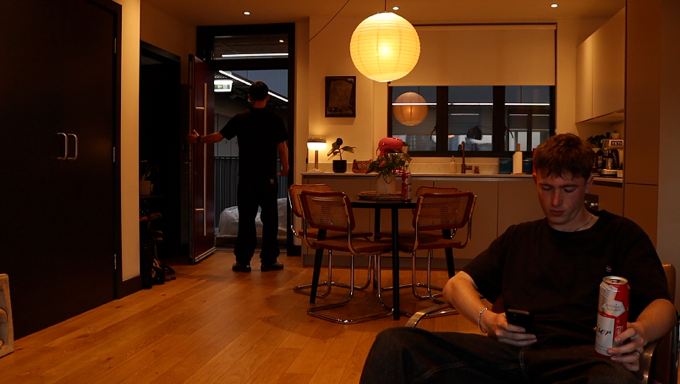
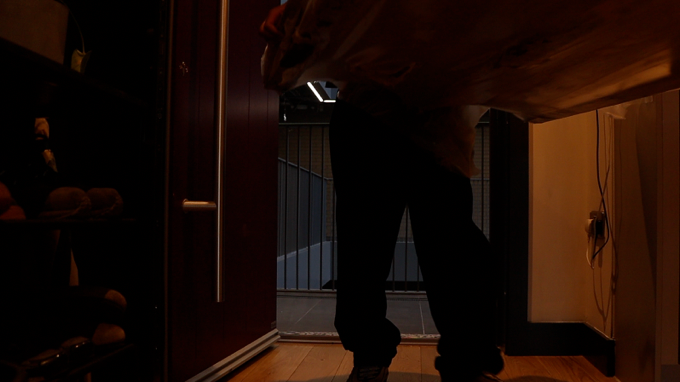
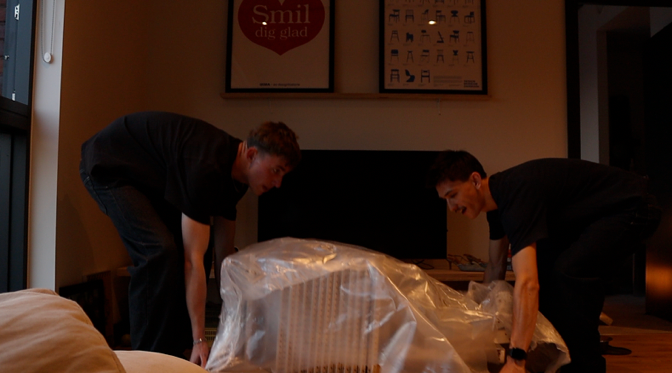
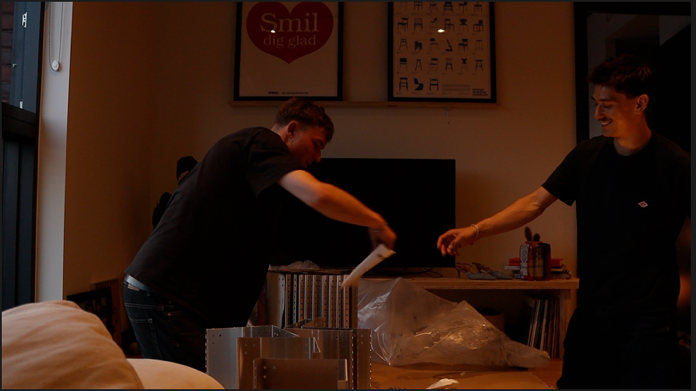
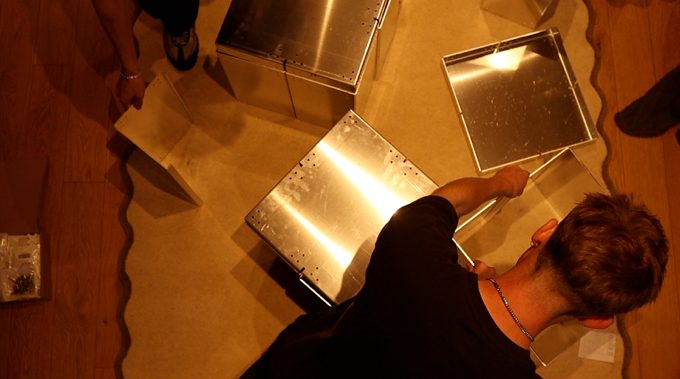
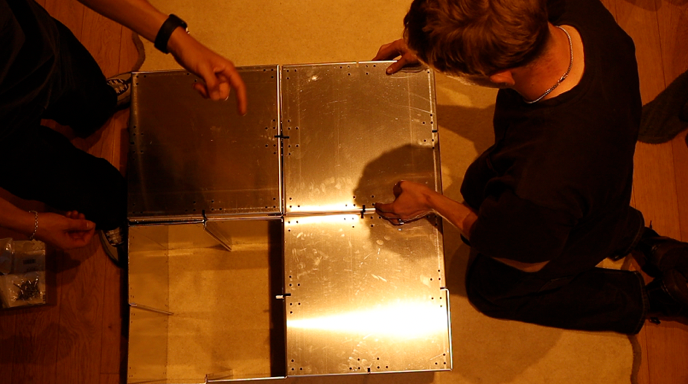
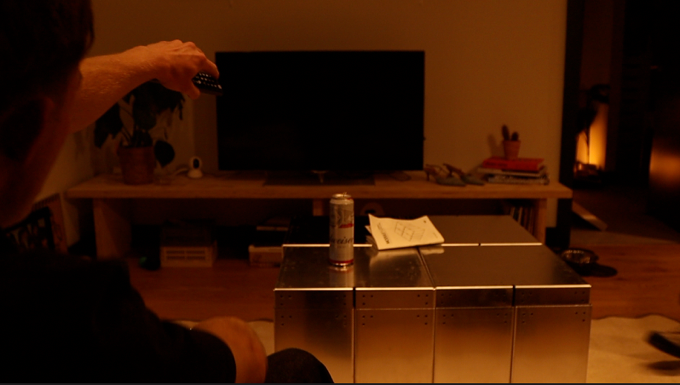
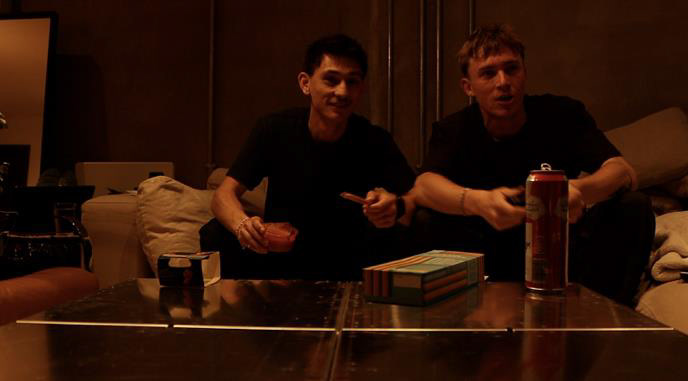
When comparing these stills to my original storyboard, it’s clear how much planning went into this piece, and I think we did a great job staying true to that vision.
Reflection
Looking back at the development of this short film, I’ve definitely gone through a full creative cycle — starting with one idea, losing control of that plan, adapting it, and actually ending up somewhere that feels a lot more honest and true to the project.
The original concept was built around a romantic narrative. It made sense — the idea of a date night, emotional connection, and a slow-burn build toward intimacy naturally mirrored the narrative of assembling the modular piece. It was playful and cheesy on purpose, which I liked. The closing shot of clothes flying off-screen added just enough drama without taking itself too seriously. But, in reality, that version never made it past planning.
Casting was the first major challenge. When my original models pulled out, I was left with two male friends who were keen to help, but didn’t feel comfortable acting out a flirty, intimate story. At first it felt like a setback — that I’d lost the whole tone and intention of the film — but this actually became one of the more rewarding pivots. I reworked the script with them in mind, leaning into a more believable, friendship-based dynamic. In doing that, I realised the heart of the concept didn’t rely on romance — it was about connection. That could mean anything.
The new version of the film centres on the arrival and build of the coffee table, and the kind of chilled, lived-in connection between mates. It’s less cinematic in the traditional sense, but more grounded, and I think more relatable. It’s not glossy or sentimental — it’s messy, slightly distracted, interrupted by football — and it captures the way objects like furniture become embedded in real social spaces, not just styled scenes.
There were still challenges with the shoot. Working in my own flat meant navigating awkward camera setups and limited lighting, especially during transitions from day to night. I also had to balance performance and direction while acting as camera operator, which slowed things down and made some shots harder to achieve exactly as I’d imagined. On the flip side, having control over the environment helped massively with continuity, and made it easier to rehearse moments between takes without pressure.
One of the biggest wins, though, was the shift in tone. I found that the humour and natural pacing of the revised script actually carried the story more effectively. The dialogue was more relaxed, the reactions were authentic, and the energy between the two characters felt unforced. Even the build process — which could have felt dry — gained momentum through their interactions and reactions to the football. It felt like a real evening, not a performance.

